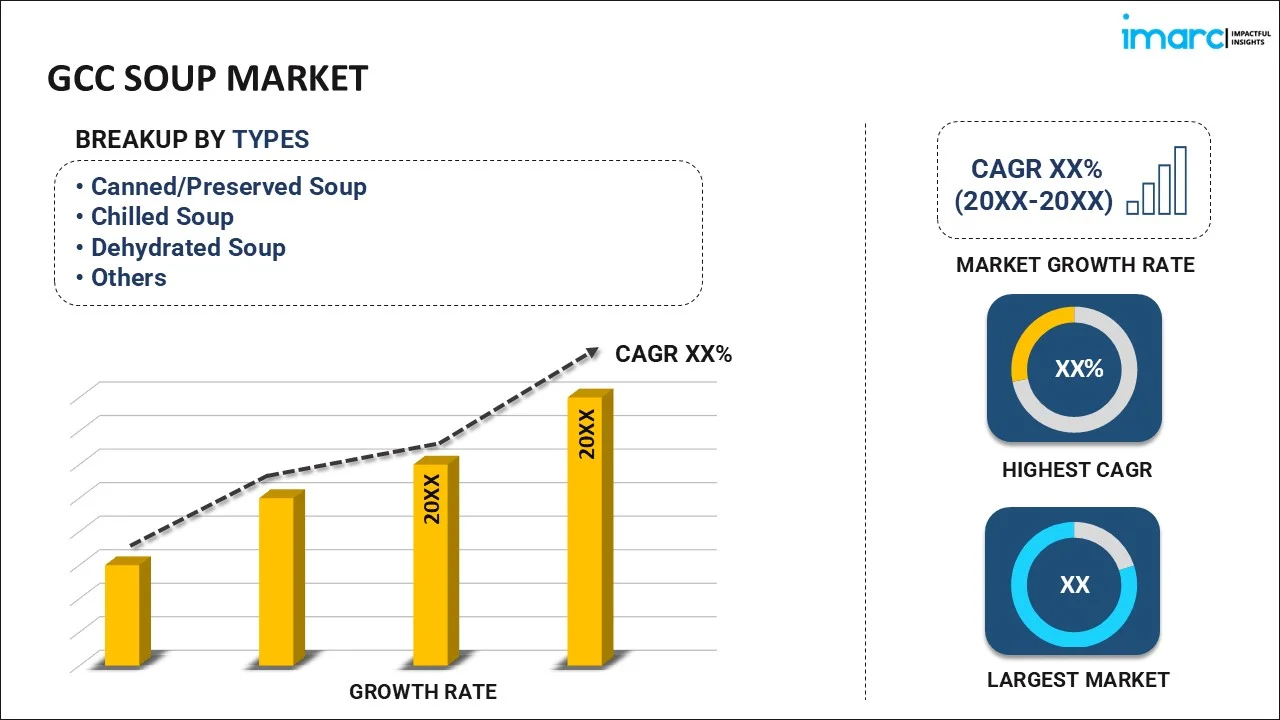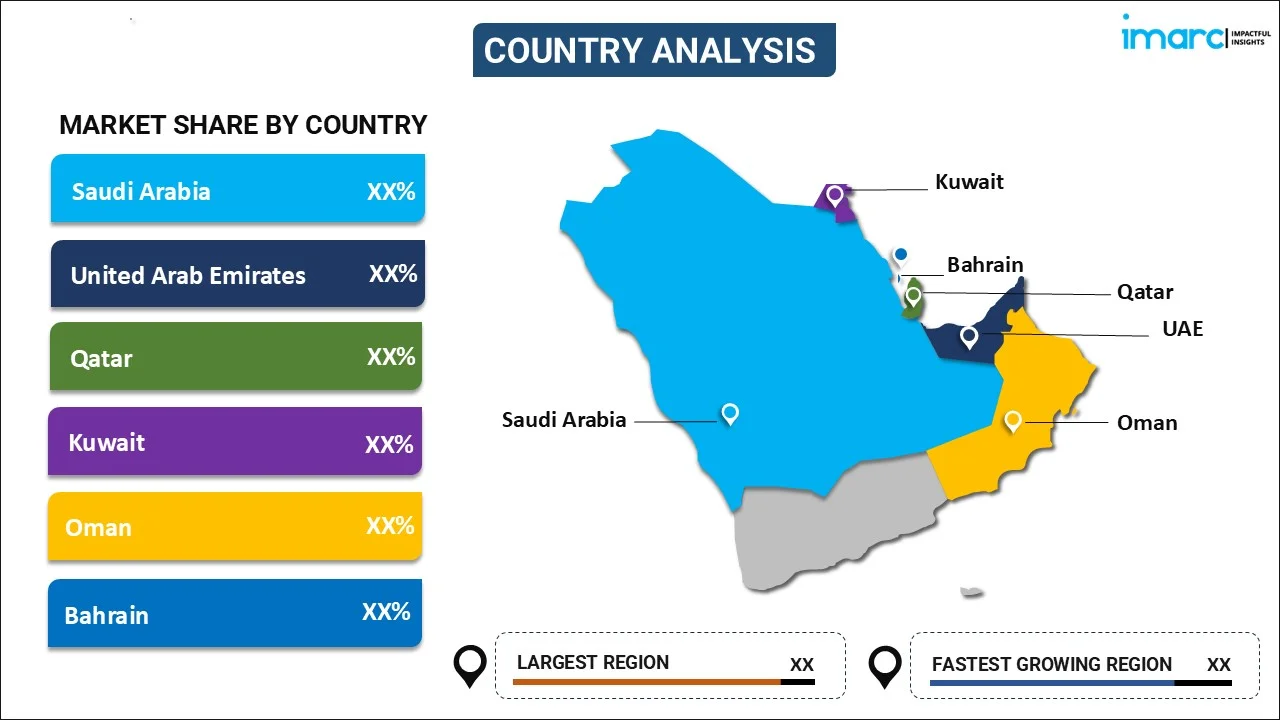
GCC Soup Market Report by Type (Canned/Preserved Soup, Chilled Soup, Dehydrated Soup, Frozen Soup, UHT Soup), Category (Vegetarian Soup, Non-Vegetarian Soup), Packaging (Canned, Pouched, and Others), Distribution Channel (Supermarkets and Hypermarkets, Convenience Stores, Online Stores, and Others), and Country 2025-2033
Market Overview:
The GCC soup market size reached USD 200 Million in 2024. Looking forward, IMARC Group expects the market to reach USD 300 Million by 2033, exhibiting a growth rate (CAGR) of 3.8% during 2025-2033. The growing demand for convenient and time-saving food options, the increasing focus on health and wellness, the introduction of new flavors and variants, and the rising disposable incomes of individuals represent some of the key factors driving the market.
|
Report Attribute
|
Key Statistics
|
|---|---|
|
Base Year
|
2024 |
|
Forecast Years
|
2025-2033
|
|
Historical Years
|
2019-2024
|
| Market Size in 2024 | USD 200 Million |
| Market Forecast in 2033 | USD 300 Million |
| Market Growth Rate (2025-2033) | 3.8% |
Soup is a liquid food typically made by combining various ingredients such as vegetables, meat, poultry, seafood, legumes, grains, or herbs in a broth or stock. It is a versatile dish that can be served hot or cold and is commonly consumed as a starter or main course in many cuisines around the world. The preparation of soup involves simmering the ingredients together in a liquid base to extract flavors and create a flavorful and nourishing broth. The liquid base can be water, stock such as chicken, beef, vegetable, or seafood stock or a combination of both. Soup can be classified into various types based on its consistency and ingredients. It is also packed with vitamins, minerals, and fiber, when prepared with an abundance of vegetables and lean proteins. Additionally, homemade soups allow for control over the ingredients and seasoning, making it a healthier alternative to many pre-packaged or processed foods. As a result, soup is widely consumed by individuals of all age groups across GCC countries.
GCC Soup Market Trends:
The market is primarily driven by the shifting consumer preference across the region. Nowadays, with increasing urbanization and the rising number of working individuals, there is a growing demand for convenient and time-saving food options. Ready-to-eat soups offer a quick and easy meal solution, catering to the needs of busy consumers. In addition, there is a growing focus on health and wellness in the GCC region, with consumers seeking healthier food options. Soups are often perceived as nutritious and wholesome, particularly if they contain vegetables, legumes, and lean proteins. The demand for soups with low sodium, low fat, and organic ingredients is increasing as consumers prioritize their well-being. Besides, the convenience factor plays a crucial role in driving the soup market in the GCC. Ready-to-eat soups require minimal preparation and cooking time, making them an attractive option for individuals with busy schedules or limited cooking skills. The availability of a wide variety of canned, packaged, and instant soups further contributes to the market growth. Moreover, the GCC region attracts a significant number of tourists and hosts numerous business events and conferences. The tourism and hospitality sector is driving the demand for soups, as hotels, restaurants, and catering services include soups in their menus to cater to the diverse tastes of visitors. Furthermore, manufacturers are constantly developing new soup recipes, exploring exotic flavors, and incorporating unique ingredients to attract consumer attention and cater to evolving tastes, which is also creating a favorable market outlook across the region.
GCC Soup Market Segmentation:
IMARC Group provides an analysis of the key trends in each segment of the GCC soup market report, along with forecasts at the regional and country levels for 2025-2033. Our report has categorized the market based on type, category, packaging, and distribution channel.
Type Insights:

- Canned/Preserved Soup
- Chilled Soup
- Dehydrated Soup
- Frozen Soup
- UHT Soup
The report has provided a detailed breakup and analysis of the GCC soup market based on the type. This includes canned/preserved soup, chilled soup, dehydrated soup, frozen soup, and UHT Soup.
Category Insights:
- Vegetarian Soup
- Non-Vegetarian Soup
The report has provided a detailed breakup and analysis of the GCC soup market based on the category. This includes vegetarian and non-vegetarian soup.
Packaging Insights:
- Canned
- Pouched
- Others
The report has provided a detailed breakup and analysis of the GCC soup market based on the packaging. This includes canned, pouched, and others.
Distribution Channel Insights:
- Supermarkets and Hypermarkets
- Convenience Stores
- Online Stores
- Others
A detailed breakup and analysis of the GCC soup market based on the distribution channel has also been provided in the report. This includes supermarkets and hypermarkets, specialty stores, online stores, and others.
Country Insights:

- Saudi Arabia
- United Arab Emirates
- Qatar
- Bahrain
- Kuwait
- Oman
The report has also provided a comprehensive analysis of all the major regional markets, which include Saudi Arabia, the United Arab Emirates, Qatar, Bahrain, Kuwait, and Oman.
Competitive Landscape:
The report has also provided a comprehensive analysis of the competitive landscape in the GCC soup market. Competitive analysis such as market structure, key player positioning, top winning strategies, competitive dashboard, and company evaluation quadrant has been covered in the report. Also, detailed profiles of all major companies have been provided.
Report Coverage:
| Report Features | Details |
|---|---|
| Base Year of the Analysis | 2024 |
| Historical Period | 2019-2024 |
| Forecast Period | 2025-2033 |
| Units | Million USD |
| Scope of the Report | Exploration of Historical and Forecast Trends, Industry Catalysts and Challenges, Segment-Wise Historical and Predictive Market Assessment:
|
| Types Covered | Canned/Preserved Soup, Chilled Soup, Dehydrated Soup, Frozen Soup, UHT Soup |
| Categories Covered | Vegetarian Soup, Non Vegetarian Soup |
| Packagings Covered | Canned, Pouched, Others |
| Distribution Channels Covered | Supermarkets and Hypermarkets, Specialty Stores, Online Stores, Others |
| Countries Covered | Saudi Arabia, the United Arab Emirates, Qatar, Bahrain, Kuwait, Oman |
| Customization Scope | 10% Free Customization |
| Post-Sale Analyst Support | 10-12 Weeks |
| Delivery Format | PDF and Excel through Email (We can also provide the editable version of the report in PPT/Word format on special request) |
Key Questions Answered in This Report:
- How has the GCC soup market performed so far and how will it perform in the coming years?
- What has been the impact of COVID-19 on the GCC soup market?
- What is the breakup of the GCC soup market on the basis of types?
- What is the breakup of the GCC soup market on the basis of distribution channel?
- What is the breakup of the GCC soup market on the basis of category?
- What is the breakup of the GCC soup market on the basis of packaging?
- What are the various stages in the value chain of the GCC soup market?
- What are the key driving factors and challenges in the GCC soup market?
- What is the structure of the GCC soup market and who are the key players?
- What is the degree of competition in the GCC soup market?
Key Benefits for Stakeholders:
- IMARC’s report offers a comprehensive quantitative analysis of various market segments, historical and current market trends, market forecasts, and dynamics of the GCC soup market from 2019-2033.
- The research study provides the latest information on the market drivers, challenges, and opportunities in the GCC soup market.
- Porter's five forces analysis assist stakeholders in assessing the impact of new entrants, competitive rivalry, supplier power, buyer power, and the threat of substitution. It helps stakeholders to analyze the level of competition within the GCC soup industry and its attractiveness.
- Competitive landscape allows stakeholders to understand their competitive environment and provides an insight into the current positions of key players in the market.
Need more help?
- Speak to our experienced analysts for insights on the current market scenarios.
- Include additional segments and countries to customize the report as per your requirement.
- Gain an unparalleled competitive advantage in your domain by understanding how to utilize the report and positively impacting your operations and revenue.
- For further assistance, please connect with our analysts.
 Inquire Before Buying
Inquire Before Buying
 Speak to an Analyst
Speak to an Analyst
 Request Brochure
Request Brochure
 Request Customization
Request Customization




.webp)




.webp)












